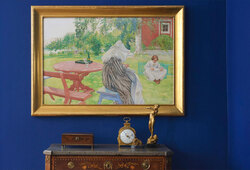A South East Asian wooden sculpture of Garruda, early 20th Century.
Carved, painted and gilded decoration. Height 69 cm.
Wear, damages.
Provenance
From the The Bengt and Lilavati Häger Collection.
Lilavati and Professor Bengt Häger’s art collection was culturally significant and vast. It is clear that it was founded on the couples cross cultural experiences. Lilavati was a leading exponent of Indian dance and Bengt one of the most important European Impresarios of his day.
Multitalented and highly regarded Bengt Häger (1916-2011) worked inexhaustibly throughout his life to promote dance as an independent art form and field of research. He founded and managed the Swedish Dance Museum, the University Collage of Dance and Circus in Stockholm. He worked actively to bring international guest performances from world leading dance companies. Organized international tours for Swedish dance companies such as the Cullberg Ballet, which he managed 1967-1987. He was the first to bring Peking Opera out of China after the revolution and was a great friend of the renowned Peking Opera singer Mai Lanfang.
For many years Mr Häger was the closest friend and collaborator of the famous Art Collector Rolf the Maré (1888-1964), founder of Ballet Suedois in Paris. Bengt was also involved with UNESCO and founded the Centre International de Dance.
Lilavati Devi (1925-2002). First came to Sweden as a principal performer of the dance company set up by Ram Gopal (1912-2003), the Nijinsky of India. Bengt and Lilavati married in 1954. She became an important ambassador of Indian Dance in Scandinavia. They couple came to inhabit a circle that included some of the major international dancers, performers and choreographers of the last Century.
Exhibitions
To see other items Sold from this collection see Bukowskis Auction 601.
More information
This wooden sculpture of a bird-like creature is found in many parts of South East Asia. In Thailand and Indonesia he is their national symbol, and is part of the Buddhist faith.
In India he is the god or deity known as 'Garuda' and is part of the Hindu group of gods. His job is to carry the important god Vishnu on his back and there are stories about him in the Hindu story called The Mahabaratha.




























































